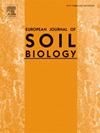The making of a (soil) star: phylogenetic relationships of the genus Lumbricus with insight into its evolution and biogeography
IF 3.3
2区 农林科学
Q1 ECOLOGY
引用次数: 0
Abstract
The widely distributed earthworm genus Lumbricus exhibits significant ecological and morphological diversity, playing essential roles in soil ecosystems. This study presents a comprehensive molecular phylogeny of the genus, incorporating eighteen taxa and four mitochondrial and anuclear marker. The aim was to clarify the phylogenetic relationships within Lumbricus and examine the evolutionary trajectory of bioturbation behaviour and geographic origins.
Phylogenetic analyses revealed three major clades within Lumbricus, with Lumbricus baicalensis emerging as the earliest branching species. Evolutionary relationships suggested that the common ancestor of the genus was an epigeic litter dweller, with epi-anecic traits appearing later in their evolutionary history. Ancestral area reconstruction indicated that the genus originated in France and Central Europe, aligning with previous hypotheses of an Alpine origin. Molecular phylogenetics reinforced the monophyly of the genus, confirming the species status of previously unassessed taxa, such as Lumbricus meliboeus and Lumbricus polyphemus. Additionally, high genetic divergence was found between some infraspecific taxa, suggesting that Lumbricus castaneus var. disjunctus and Lumbricus rubellus castaneoides may represent pseudocryptic species. Previous hypotheses about the giant endemic species Lumbricus badensis evolving from a common ancestor with Lumbricus friendi around the Last Glacial Maximum were not supported by our results.
These findings contributed an evolutionary and biogeographic background to understand the current ecology and distribution of invasive Lumbricus species such as Lumbricus terrestris or Lumbricus castaneus, potentially opening the way to improved management of these impactful species.

一颗(土壤)星的形成:蚓属的系统发育关系及其进化和生物地理学的见解
蚓属蚯蚓分布广泛,具有显著的生态和形态多样性,在土壤生态系统中起着重要作用。本研究提出了一个全面的分子系统发育属,包括18个分类群和4个线粒体和核标记。目的是澄清在蚓内的系统发育关系,并检查生物扰动行为和地理起源的进化轨迹。系统发育分析揭示了蚓科的三个主要分支,其中黄芩是最早的分支种。进化关系表明,该属的共同祖先是后生凋落物居民,后生特征出现在他们的进化史上较晚。祖先区域重建表明,该属起源于法国和中欧,与先前的阿尔卑斯起源假说一致。分子系统发育强化了该属的单一性,证实了以前未被评估的分类群,如Lumbricus meliboeus和Lumbricus polyphemus的物种地位。此外,在一些种下分类群之间发现了高度的遗传差异,表明麻条蚓和麻条蚓可能是假隐种。先前关于巨型特有物种巴氏Lumbricus badensis是在末次盛冰期前后与友氏Lumbricus friendi由共同祖先进化而来的假设,并没有得到我们研究结果的支持。这些发现为了解陆生蚓(Lumbricus terrestris)和castaneus等入侵蚓类物种的生态和分布提供了进化和生物地理背景,为改善这些有影响的物种的管理开辟了道路。
本文章由计算机程序翻译,如有差异,请以英文原文为准。
求助全文
约1分钟内获得全文
求助全文
来源期刊

European Journal of Soil Biology
环境科学-生态学
CiteScore
6.90
自引率
0.00%
发文量
51
审稿时长
27 days
期刊介绍:
The European Journal of Soil Biology covers all aspects of soil biology which deal with microbial and faunal ecology and activity in soils, as well as natural ecosystems or biomes connected to ecological interests: biodiversity, biological conservation, adaptation, impact of global changes on soil biodiversity and ecosystem functioning and effects and fate of pollutants as influenced by soil organisms. Different levels in ecosystem structure are taken into account: individuals, populations, communities and ecosystems themselves. At each level, different disciplinary approaches are welcomed: molecular biology, genetics, ecophysiology, ecology, biogeography and landscape ecology.
 求助内容:
求助内容: 应助结果提醒方式:
应助结果提醒方式:


